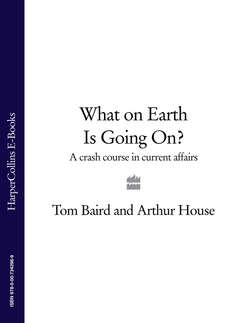Читать книгу What on Earth is Going On?: A Crash Course in Current Affairs - Arthur House - Страница 9
ОглавлениеBasque Country/ETA
Where is it?
The Basque Country is a rugged and beautiful region of northern Spain and south-western France that straddles the Pyrenees and borders the Bay of Biscay. It is made up of seven provinces—four in Spain and three in France—and is a popular tourist destination that includes cities such as Bilbao and Pamplona, and the seaside resorts of Biarritz and San Sebastián. The Basque people are one of Europe’s most ancient ethnic groups, and they have fought hard to hold on to their culture and land over the centuries. Their language, Euskara, is one of the oldest in the continent, and isn’t related to any other. The French Basque region (Pays Basque) has mostly avoided the violent struggle for independence associated with its Spanish equivalent (País Vasco).
How is Spain governed?
Compared to most other nations in Western Europe, Spain is remarkable for its decentralised system of government. The 1978 Constitution, which marked the return to democracy following Francisco Franco’s fascist dictatorship, allowed Spain’s local regions to become ‘autonomous communities’ with their own government and parliament, ruling themselves with differing degrees of independence from the central government in Madrid. There are now 17 of these autonomous communities, including Andalusia in the south, Catalonia in the north-east and the Basque Country in the north (this is composed of three of the four Spanish Basque provinces, while the remaining province, Navarre, is a separate autonomous community). The Basque Country currently enjoys the highest level of autonomy, with education and tax collection among the responsibilities of the region’s parliament.
How did the Spanish Civil War affect the Basque Country?
During the 1936-9 Spanish Civil War the Basque people sided with the republican government against the nationalist forces of General Franco. Franco was the latest in a long line of threats to the Basque Country, which had in its troubled history held off Romans, Vikings, Visigoths and Moors. When Franco came to power in 1939 he sought retribution, and punished the region for its resistance by banning its language and neglecting its economy. It was during Franco’s reign that the group ETA appeared in 1959, and it has remained active ever since.
What is ETA?
ETA stands for Euskadi Ta Azkatasuna (‘Basque Homeland and Freedom’). It is a separatist organisation calling for complete independence in all seven provinces of the Basque region in both Spain and France. Spain, the European Union and the US all regard the group as a terrorist organisation, and since forming it has been responsible for killing over 800 people. Police, politicians and the general public have all been victims of ETA’s violent campaign—for example, police chief Melitón Manzanas was murdered in 1968; Spanish Prime Minister Luis Carrero Blanco was assassinated in 1973; and a car bomb set off by ETA killed an American tourist in 1985. ETA’s political wing, Herri Batasuna (‘Unity of the People’), was formed in 1978 in reaction to the new Spanish constitution, and fostered close links with the Irish republican party Sinn Féin.
What did the Spanish government do?
In the 1980s, Felipe Gonzalez’s government made a botched attempt at combating ETA by setting up Anti-Terrorist Liberation Groups (GAL); essentially these were mercenaries charged with assassinating key members of the separatist organisation. However, 10 of the 28 people killed by the GAL between 1983-7 turned out to have nothing to do with ETA, which led to the jailing of some of those who had set up the death squads.
Does ETA have public support?
There was strong support for ETA in the Basque provinces during Franco’s reign and into the 1980s: more than half of those surveyed in a poll there in 1979 felt ETA’s militants were ‘patriots’ or ‘idealists’. However, in general, support for ETA has waned since the Franco years as the group sought civilian rather than military targets and its actions became increasingly bloody. In 1997, 6 million Spaniards protested against ETA’s killing of a young local councillor from the Basque region.
Recently ETA’s strength has been sapped further; its political wing was banned in 2003, and, despite broken ceasefires and continued car-bomb attacks on politicians, judges and journalists, the Spanish government—under the leadership of José Luis Rodriguez Zapatero since 2004—seems to be winning the battle against the organisation. ETA’s military commander Garikoitz Aspiazu Rubina and suspected leader Javier López Peña were both caught in 2008; in all some 750 suspected members of the organisation have been detained since 2000. In March 2009, ETA suffered another big blow when 29 years of nationalist domination in the Basque Country came to an end as the Basque Nationalist Party failed to muster a majority in the region’s elections. This paved the way for the Socialist Party and Popular Party to create an informal coalition. They strongly support the Basque Country remaining part of Spain, and have promised to boost funding to combat ETA.
Guernica
The Spanish artist Pablo Picasso painted his iconic image of Guernica, a town in the Basque Country, after more than one and a half thousand people were killed when bombs were dropped by the Luftwaffe in 1937, in the first major air raid specifically aimed at killing civilians.
Basquetball
The second-largest Basque city of Vitoria-Gasteiz is home to one of Europe’s top basketball clubs, Tau Ceramica. In addition, the Basque people have produced a number of star sportsmen over the years, including the footballers Xabi Alonso, Mikel Arteta, Didier Deschamps, Bixente Lizarazu; rugby players Serge Blanco and Imanol Harinordoquy; cyclist Miguel Indurain and golfer José María Olazábal.
